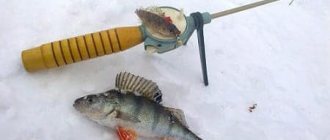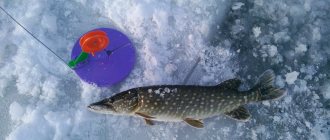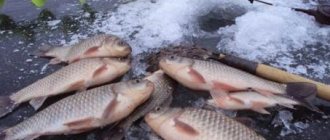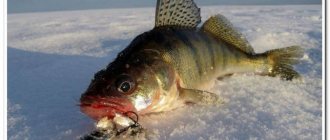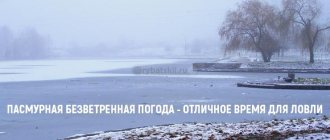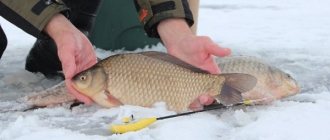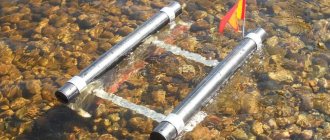Published: 02/28/2019
The ice regime of a reservoir is the cycle of covering the water area with ice, unchanged every year. On the reservoirs of the Leningrad region, the ice regime consists of three phases: freezing, freeze-up and opening of reservoirs.
For ice to form in water bodies it is necessary:
– slight hypothermia of water, the temperature should be slightly below 0 ° C, starting from hundredths and below;
– the presence of crystallization nuclei, which can be snowflakes, pieces of ice, mineral and organic suspensions;
– turbulent mixing to remove the heat released during crystallization. If there is no stirring, the crystallization process stops.
In reservoirs, surface and deep (intra-aquatic) ice is formed, crystallizing not only on suspension, but also on microorganisms, sand particles, pebbles, etc. The freezing temperature decreases with depth and with increasing mineralization.
Factors that determine the possibility of the formation of ice phenomena include:
• intensity of heat transfer from the surface of a reservoir with the onset of cold weather;
• the value of the heat capacity of the reservoir. The larger the volume of water mass in a reservoir, and the deeper it is, the longer the cooling process;
• mixing intensity associated with transit currents. The more flowing the body of water, the more intense the transfer of heat from the deep layers to the surface, into the atmosphere.
Wind is a very important factor in the formation of ice cover on reservoirs and the onset of freeze-up. The stronger the wind, the more intense the heat transfer into the atmosphere due to evaporation and turbulent heat exchange with frosty air. Mixing of layers of water by wind and waves enhances heat exchange and the removal of warm deep water to the surface, which slows down the process of ice formation. Intensive mixing increases the thickness of the water layer, in which the formation of ice crystals that float to the surface of the water is possible (ice has a density 10% less than the density of water). Wind waves destroy the formed ice crusts, which slows down the formation of the ice cover.
Freezing of reservoirs.
With intense heat exchange and cooling of the waters of a reservoir, but in the absence of wind and mixing of the upper layer of water, primary ice crystals form in the form of small needles. When the water is covered with them, it seems that melted fat is spilled on its surface. This state of the water-crystallized mixture is called “fat”. With continued frost and no wind, the crystals freeze together. Homogeneous transparent crystalline ice is formed, the thickness of which increases quite quickly. During a clear and frosty night, the thickness of such ice can reach 2-3 cm. In this case, as a rule, the entire small body of water freezes at the same time. On large lakes in such weather, only shallow bays are usually covered with ice.
Crystalline ice at the beginning of winter is the strongest and, at a thickness of 5 cm, can withstand the weight of a person, and at 10 cm, a snowmobile. In lakes covered with ice in frosty, calm weather, reverse stratification remains under the ice with a relatively thin subglacial layer of water cooled to 0 °C. If the freezing of a reservoir occurred in windy weather with mixing and more intense heat transfer from the water surface, the average water temperature in the reservoir in winter is lower.
Even with a weak wind, the freezing of the reservoir begins from the coastal shallows, which cool faster due to the shallow depth. Primary crystals gather towards the edge and freeze, forming stripes of crystalline ice - banks frozen to the coastal slope. As frost intensifies, the banks expand and the open water surface shrinks. On large and deep lakes and reservoirs, freezing takes a long time and occurs at different times in different areas.
The formation of ice cover involves floating lumps of intra-water ice (slush), usually of a dirty white color, snow, formed from snow in a disturbed, not yet frozen water surface. The unevenness of such cover increases if strong winds and fluctuations in the surface of the reservoir break up the ice that has not yet hardened. It crushes, and its pieces rubbing against each other turn into pancake ice - disc-shaped pieces of ice with a convex white edge of frozen ice crumbs.
The storm wind breaks up already quite strong ice, the ice floes move one on top of the other and freeze into hummocks with the onset of less windy, but frosty weather. In stormy areas, coastal ice ridges are formed from broken ice, slush and particles of bottom soil in stormy areas of a gently sloping coast.
Hardened ice
Winter takes its toll and, despite weather collisions, soon all reservoirs are covered with ice, the thickness of which in winters with little snow and frost in central Russia reaches 1 meter or more. This is the calmest (in terms of safety) period of winter fishing, although even here very unpleasant surprises can await the fisherman.
First of all, you need to keep an eye out for rivers when the ice is covered with a thick layer of snow, blocking the access of cold to the ice, and the flowing water slowly but surely begins to wear it away from below. Most quickly, gullies are formed where the jets, swirling over obstacles, shoot upward, above the outlet of spring waters or at the point where warm domestic waste flows.
Typically, the location of such areas remains the same every year and you just need to remember them well. On an unfamiliar river, it is better to walk along well-worn paths, and test untrodden areas by frequently drilling test holes - although this is tedious, it is justified.
One day in the middle of winter and after severe frosts, I was walking quickly along the river, approaching an area with a fast current. The ice auger was deployed, but confidence in the strength of the ice prevailed over caution. I found myself in the icy water instantly, without feeling any resistance. And the torn (through a thick mitten) skin between the thumb and forefinger and the slightly bent auger eloquently testified that the ice auger that stood across the manna with seething black water saved me. It turns out that the gulley was covered only by a fragile crust of snow frozen from below...
When fishing on stagnant bodies of water, especially on reservoirs where there is a constant discharge of water, you should remember that the ice here breaks off from time to time near the shores. If in shallow water it lies on the ground, then along steep banks there may be areas of unfrozen water, only covered with drifted snow (Fig. 5), where you can quite unexpectedly end up, ruining your fishing.
A variant of the formation of an ice font near a steep bank when water is released.
It is also an unpleasant situation when you find yourself in the vast expanse of a large body of water in an area with a water bath hidden by a thick layer of wet snow. Such baths are formed precisely in those places where the ice is thin: after prolonged snowfalls, it cannot withstand the mass of snow, bursts with the formation of through cracks, into which water enters in an amount equal to the weight of the load (Fig. 6). The already thin ice now saturated with water stops freezing and becomes very dangerous, especially closer to spring.
Formation of water lenses on ice during snowy winters: mc is the mass of snow; mb is the mass of water released onto the ice.
It should also be remembered that in reservoirs, especially the Volga cascade, by the middle of winter, due to the release of water, the flow increases so much that huge gullies appear, initially covered with thin, not yet eroded ice. In this situation, the ice pick should complement the ice auger, and the return road should be checked several times a day.
Structure and deformation of the ice cover.
Freeze-up is a period of stationary ice cover. In Lake Ladoga, during a warm winter with a small amount of negative air temperatures, the area of ice cover does not exceed 50% of the water area. In such winters, the heat reserve of its water mass is the smallest due to particularly intense heat transfer from the large open water surface. In moderately cold winters, almost 100% ice coverage lasts only 2 months, and in severe winters it lasts almost 3 months.
The rate of growth of the crystalline layer of ice (due to crystallization of water on its lower surface) depends on its thermal conductivity and how intense the heat loss from the ice cover to the atmosphere during frost. The lower the air temperature and the longer the frosty weather, the more ice freezes from below, the thicker the crystalline ice on the reservoir becomes, and the thermal insulation of the water underneath increases.
Ice cover deformations.
In winter, ice, like any solid body, contracts when cooled. The compression is greater at the upper surface of the ice, where frost cracks begin. The lower surface of the ice freezes firmly in shallow water to the soil near the edge, therefore, as frost intensifies, the ice cover ruptures in the cracks, and in cracks that widen to 1-2 m, a crust of young ice forms on the water. With warming, the ice expands and cracks move, causing hummocking of young ice. Hummocks sometimes reach a height of 0.5-1.5 m.
In addition to thermal deformations of the ice cover, dynamic deformations also occur on lakes caused by seiches (standing waves that occur in closed or partially closed reservoirs) in open water. On Lake Ladoga, three cracks repeatedly appeared along the longitudinal axis and across it under the influence of a multi-node seiche, when the greatest bends of the ice cover occur in the coastal zone. In severe frost, a slight bend of the ice field above the antinode of the seiche is enough for it to crack.
The anticipation of the holiday is better than the holiday itself
I think that many are just as eagerly awaiting their first time on the ice as my wife and I are. Why is our brother so attracted to this short period of fishing, which is unstable in nature? Probably because the very possibility of fishing from ice looks like some kind of miracle, because on “solid” water you can go to the most secluded places of reservoirs, where only yesterday access was only by boat. And the fish are caught literally from under the “floor”, the role of which will be played by the ice crust in the next few months. And this is very cool! After all, fishing is loved all over the globe, but not everywhere there is an opportunity to fish both in open water and from ice.
But there is one big fly in the ointment in this fishing holiday - this is a serious danger that awaits those who are in a hurry to go out on the first ice. Alas, the excitement and desire to be the first in cool places is so great that our brother often forgets about basic safety rules. And sometimes the price for such forgetfulness is too high. Let’s be honest: even since my school years I can’t get rid of the burning desire to appear on the ice in the front row.
It’s good that now my constant fishing companion is my wife, who, with the caution and foresight characteristic of women, restrains my risky impulses. And if we evaluate the results of our fishing trips based on the very first ice over the last ten years (that’s how long I’ve been scrupulously keeping a fishing diary), it turns out that the vast majority of such outings were either ineffective or without a catch at all.
Why does this happen and where did the persistent myth among fishermen come from that the best bite is observed on the first ice? I think fishing books and reference books played a role, from where we got information in the pre-Internet era - after all, in the sections about winter fishing we will definitely find enthusiastic lines about how excellent the fish are caught during the period of first ice. And even now on the Internet, authors who do not bother to analyze their own experience (if any), but simply relay in their own words the pages of the same academic reference books, continue to replicate and bring to the fishing masses the persistent myth that the first ice is a fish meal . However, fish are illiterate creatures, they haven’t gone through academies, they haven’t read fishing guides, and therefore they have their own opinion about biting on the first ice. And it often turns out that in the first ice the fishing results are not at all rosy.
Let's figure out why this happens.
Firstly, the fact is that the period of ice formation is often associated with various weather disasters. After all, the radical transition of weather from winter to summer does not occur painlessly. And it is often associated with strong winds and significant jumps in air pressure and temperature in one direction or another. Weather swings from autumn to winter and back can last for several days, or even for weeks.
Fish react very sensitively to changes in weather, and this usually manifests itself in a significant deterioration in the bite or its complete cessation. Actually, this happens at any border time of the year. But in the pre-winter period, when changes in weather occur especially sharply and dramatically, fish can completely lose their appetite for a long time.
There is also an option when the cold comes immediately and sharply. It happens that the territory is covered by a vast anticyclone with low temperature and extremely high pressure. The frost presses down, and the reservoirs are frozen with ice very quickly - literally in a couple of nights. Especially if by this time the water has already cooled down sufficiently. But even in this case, it is reckless to count on the first-ice zhor, because high pressure and severe frosts, which also came quite sharply, put the fish into a stupor, and you need to wait until the weather becomes milder.
The established ice cover itself, on which the angler can move fearlessly, is by no means a sign that the fish are ready to bite. Various reference books write that ice 5–7 cm thick is safe for humans, but, as is known, its strength is affected not only by thickness, but also by consistency and color.
I stepped on white milky ice during the first ice, although it was 15 centimeters thick - this did not stop it from bursting under my foot, almost silently, with a sort of quiet, telltale rustle. Therefore, everything is individual. Here I am, for example (although I’m not the best example) I go out on the ice when its thickness is 5 cm (photo 2) , and it can withstand my 90 kg (photo 3) . But my wife, even though she weighs two dozen kilograms less, cannot be driven onto the ice until it grows to 10 cm. In general, safety is determined not so much by the thickness of the ice as by the prudence of the fisherman himself.
Even fairly thick ice, when walking on it, produces a loud crackling sound, sometimes similar to gunshots. One can only imagine how a fish, accustomed to silence, perceives these sounds. When moving through shallow water, you can observe how, with every step of the fisherman to the sides, small fish scatter in horror, trying to find shelter. And this is how a small thing reacts to the cracking of ice, which is always bolder and more reckless than a big one. It is not difficult to assume that experienced individuals will be even more careful during this period, and will leave a dangerous place even before the fisherman approaches it, crunching loudly at every step and scaring away everything in its path.
Another negative factor is the transparency of the first ice, which, after formation, remains until the ice crust is powdered with snow. In sunny weather, the transparent ice shell becomes a kind of magnifying glass, enhancing the rays of light entering under the ice. In open water, this is prevented by waves, which themselves scatter light and also raise a cloudy suspension from the bottom, making the water less transparent.
In the pre-winter period, the algae in the reservoirs die off, the turbidity settles to the bottom - and the transparency of the water is close to ideal. And then there’s a huge “glass magnifying glass” that covered the entire reservoir. How cool is it if the fish feel in this lighting as if they are on an operating table...
